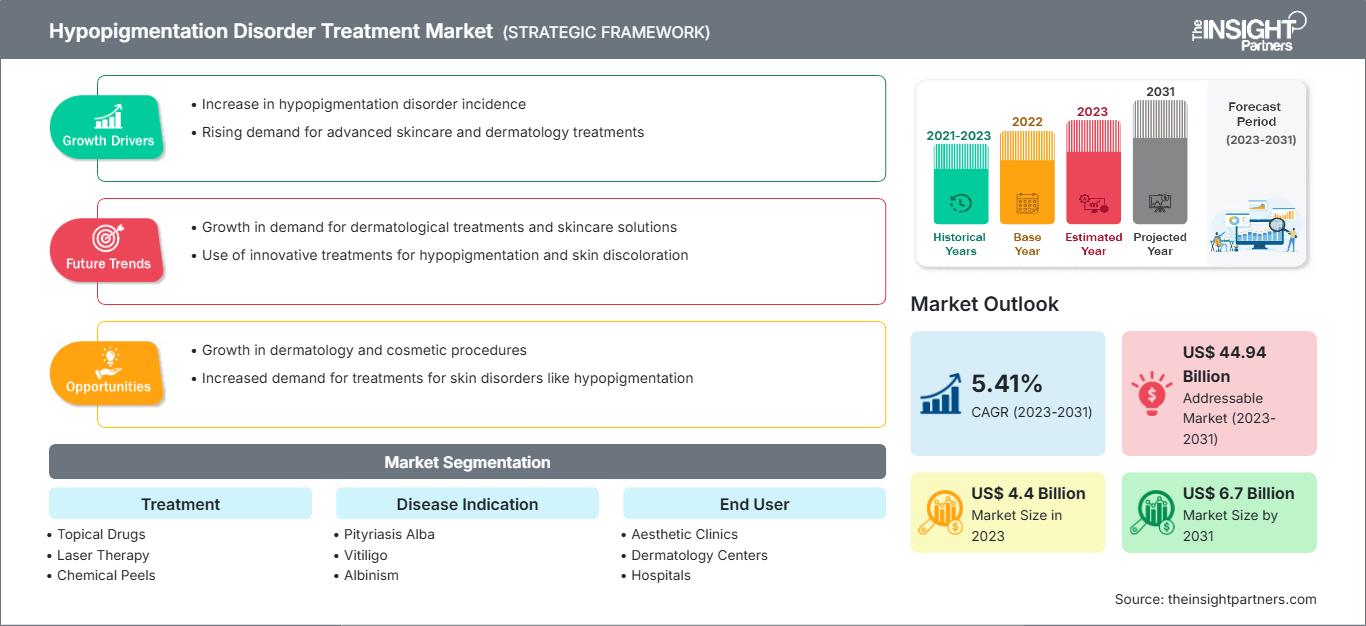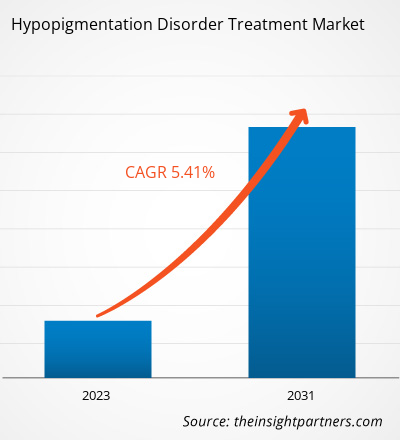[Rapporto di ricerca] Si prevede che il valore di mercato del trattamento dei disturbi da ipopigmentazione crescerà da 4,4 miliardi di dollari nel 2023 a 6,7 miliardi di dollari entro il 2031; si stima che il mercato registrerà un CAGR del 5,41% dal 2023 al 2031.
Approfondimenti di mercato e punto di vista degli analisti:
I disturbi da ipopigmentazione possono evolversi in disturbi da depigmentazione. Si tratta di una condizione in cui i livelli di pigmentazione della pelle sono inferiori a quelli ottimali, a differenza delle condizioni di depigmentazione che si verificano a causa della completa rimozione dei pigmenti. I principali fattori che guidano la crescita del mercato del trattamento dei disturbi da ipopigmentazione sono la crescente consapevolezza relativa ai disturbi da ipopigmentazione, i progressi tecnologici nei trattamenti estetici e il continuo aumento dell'invecchiamento della popolazione. Inoltre, si prevede che l'aumento dell'incidenza di disturbi correlati all'ipopigmentazione, come albinismo, post-ipopigmentazione e vitiligine, alimenterà il mercato dei trattamenti per i disturbi da ipopigmentazione nei prossimi anni. Si prevede inoltre che la crescente spesa dei consumatori per la salute della pelle e la consapevolezza relativa al trattamento favoriranno questo mercato nel prossimo futuro. L'introduzione di componenti naturali e di origine vegetale dovrebbe portare a un'evoluzione del mercato dei trattamenti per i disturbi da ipopigmentazione nei prossimi anni, poiché questi prodotti sono stati finora fondamentali per soddisfare la domanda globale di prodotti cosmeceutici. Il costo dei trattamenti estetici e della chirurgia, d'altro canto, limita la crescita del mercato.
Secondo il registro nazionale degli studi clinici (NCT), a giugno 2020, Incyte Corporation ha condotto uno studio clinico di fase II su Ruxolitinib per valutarne la sicurezza e l'efficacia nel trattamento della vitiligine in soggetti arruolati negli Stati Uniti. Pertanto, il crescente numero di studi clinici associati ai disturbi da ipopigmentazione è un altro fattore chiave che rafforza il mercato.
Fattori di crescita e sfide:
La crescente prevalenza dei disturbi da ipopigmentazione stimola la crescita del mercato
Pitiriasi alba, vitiligine, albinismo e ipopigmentazione post-infiammatoria sono tra le principali patologie associate ai disturbi da ipopigmentazione. La vitiligine è una patologia diffusa in tutto il mondo. Secondo uno studio pubblicato su Dermatology Practical and Conceptual nel dicembre 2023, la vitiligine è una patologia cutanea diffusa che colpisce entrambi i sessi. Tuttavia, è più diffusa nelle donne e oltre il 60% dei pazienti manifesta l'insorgenza della malattia prima dei 30 anni. Si prevede che l'aumento dell'incidenza e della prevalenza della vitiligine contribuirà ulteriormente alla crescente domanda di trattamenti per l'ipopigmentazione.
Secondo un articolo pubblicato sullo Zagazig University Medical Journal nel marzo 2023, i disturbi da ipopigmentazione sono un gruppo comune di dermatosi in pediatria; la prevalenza dei disturbi da ipopigmentazione varia da paese a paese, dal 3,6% al 9,9%. Inoltre, l'avvento e l'adozione di procedure mini-invasive, tempi di ricovero ospedaliero più brevi, minore dolore e minori complicanze associate alle procedure sono stati fondamentali per la crescente popolarità delle procedure mini-invasive. Secondo l'American Society of Plastic Surgeons (ASPS), nel 2021 il numero di procedure estetiche mini-invasive eseguite negli Stati Uniti è aumentato di quasi il 200% dal 2000. Pertanto, la crescente preferenza per le procedure estetiche mini-invasive stimola ulteriormente la crescita del mercato del trattamento dei disturbi da ipopigmentazione. D'altro canto, il costo della fototerapia per patologie come la vitiligine e l'albinismo è elevato. Inoltre, gli interventi chirurgici per il trattamento della vitiligine sono molto costosi. Pertanto, l'elevato costo dei trattamenti ne limita l'adozione, limitando di conseguenza la crescita del mercato del trattamento dei disturbi da ipopigmentazione.
Personalizza questo rapporto in base alle tue esigenze
Potrai personalizzare gratuitamente qualsiasi rapporto, comprese parti di questo rapporto, o analisi a livello di paese, pacchetto dati Excel, oltre a usufruire di grandi offerte e sconti per start-up e università
Mercato del trattamento del disturbo da ipopigmentazione: Approfondimenti strategici

-
Ottieni le principali tendenze chiave del mercato di questo rapporto.Questo campione GRATUITO includerà l'analisi dei dati, che vanno dalle tendenze di mercato alle stime e alle previsioni.
Segmentazione e ambito del rapporto:
L'analisi di mercato del trattamento dei disturbi da ipopigmentazione è stata condotta considerando i seguenti segmenti: trattamento, indicazione della malattia e utente finale. L'ambito geografico del rapporto di mercato del trattamento dei disturbi da ipopigmentazione include Nord America (Stati Uniti, Canada e Messico), Europa (Regno Unito, Germania, Francia, Italia, Spagna e resto d'Europa), Asia Pacifico (Cina, Giappone, India, Australia, Corea del Sud e resto dell'Asia Pacifico), Medio Oriente e Africa (Emirati Arabi Uniti, Arabia Saudita, Sudafrica e resto del Medio Oriente e Africa) e Sud e Africa. America Centrale (Brasile, Argentina e resto dell'America meridionale e centrale).
Analisi segmentale:
Approfondimenti basati sul trattamento
In base al trattamento, il mercato è segmentato in farmaci topici, terapia laser, peeling chimici, microdermoabrasione, fototerapia e altri. Il segmento dei farmaci topici ha detenuto la maggiore quota di mercato nel trattamento dei disturbi da ipopigmentazione nel 2023 e si prevede che registrerà il CAGR più elevato tra il 2023 e il 2031.
Approfondimenti basati sull'indicazione della malattia
In base all'indicazione della malattia, il mercato del trattamento dei disturbi da ipopigmentazione è segmentato in pitiriasi alba, albinismo, vitiligine, ipopigmentazione post-infiammatoria e altri. Il segmento della vitiligine deteneva una quota di mercato significativa entro il 2023 e si prevede che registrerà il CAGR più elevato tra il 2023 e il 2031.
Informazioni basate sull'utente finale
In termini di utente finale, il mercato è suddiviso in cliniche estetiche, centri dermatologici e ospedali. Il segmento delle cliniche estetiche deteneva la quota di mercato più ampia nel trattamento dei disturbi da ipopigmentazione nel 2023; si prevede inoltre che registrerà il CAGR più elevato tra il 2023 e il 2031.
Approfondimenti regionali sul mercato del trattamento del disturbo da ipopigmentazione
Le tendenze regionali e i fattori che influenzano il mercato del trattamento del disturbo da ipopigmentazione durante il periodo di previsione sono stati ampiamente spiegati dagli analisti di The Insight Partners. Questa sezione illustra anche i segmenti e la geografia del mercato del trattamento del disturbo da ipopigmentazione in Nord America, Europa, Asia-Pacifico, Medio Oriente e Africa, America meridionale e centrale.
Ambito del rapporto di mercato sul trattamento del disturbo da ipopigmentazione
| Attributo del rapporto | Dettagli |
|---|---|
| Dimensioni del mercato in 2023 | US$ 4.4 Billion |
| Dimensioni del mercato per 2031 | US$ 6.7 Billion |
| CAGR globale (2023 - 2031) | 5.41% |
| Dati storici | 2021-2023 |
| Periodo di previsione | 2023-2031 |
| Segmenti coperti |
By Trattamento
|
| Regioni e paesi coperti |
Nord America
|
| Leader di mercato e profili aziendali chiave |
|
Densità degli operatori del mercato del trattamento del disturbo da ipopigmentazione: comprendere il suo impatto sulle dinamiche aziendali
Il mercato del trattamento del disturbo da ipopigmentazione è in rapida crescita, trainato dalla crescente domanda da parte degli utenti finali, dovuta a fattori quali l'evoluzione delle preferenze dei consumatori, i progressi tecnologici e una maggiore consapevolezza dei benefici del prodotto. Con l'aumento della domanda, le aziende stanno ampliando la propria offerta, innovando per soddisfare le esigenze dei consumatori e sfruttando le tendenze emergenti, alimentando ulteriormente la crescita del mercato.

- Ottieni il Mercato del trattamento del disturbo da ipopigmentazione Panoramica dei principali attori chiave
Analisi regionale:
Il Nord America deteneva la quota maggiore del mercato del trattamento dei disturbi da ipopigmentazione nel 2023 e si prevede che manterrà la sua posizione dominante (in termini di quota) durante il periodo di previsione. Gli Stati Uniti dominano il mercato in questa regione (con la quota maggiore) e a livello mondiale. Un'infrastruttura sanitaria consolidata, una crescente consapevolezza tra le persone riguardo alla salute della propria pelle, la crescente prevalenza di malattie associate ai disturbi da ipopigmentazione e la presenza significativa di aziende che offrono interessanti opzioni di trattamento per i pazienti con iperpigmentazione post-infiammatoria sono tra i fattori degni di nota che guidano la crescita del mercato in Nord America. Inoltre, le preoccupazioni legate alla bellezza, con i crescenti standard di bellezza tra gli asiatici, l'ingresso di un gran numero di aziende nel mercato e la continua crescita di operatori affermati, sono tra i fattori chiave che contribuiscono all'espansione del mercato del trattamento dei disturbi da ipopigmentazione nell'area Asia-Pacifico.
Panorama competitivo e aziende chiave:
Le previsioni di mercato per il trattamento dei disturbi da ipopigmentazione possono aiutare gli stakeholder di questo mercato a pianificare le proprie strategie di crescita. Allergan, SkinCeuticals, Pierre Fabre Group, Incyte Corporation, Episciences Inc., Phio Pharmaceuticals, Obagi Cosmeceuticals LLC, Alvogen, Bella Aurora e AbbVie sono alcune delle aziende chiave descritte nel rapporto di mercato sul trattamento dei disturbi da ipopigmentazione. Queste aziende si concentrano sull'ampliamento della loro offerta di prodotti per soddisfare la crescente domanda dei consumatori in tutto il mondo. La loro presenza globale consente loro di servire un'ampia clientela.
- Analisi storica (2 anni), anno base, previsione (7 anni) con CAGR
- Analisi PEST e SWOT
- Valore/volume delle dimensioni del mercato - Globale, Regionale, Nazionale
- Industria e panorama competitivo
- Set di dati Excel
Report recenti
Testimonianze
Motivo dell'acquisto
- Processo decisionale informato
- Comprensione delle dinamiche di mercato
- Analisi competitiva
- Analisi dei clienti
- Previsioni di mercato
- Mitigazione del rischio
- Pianificazione strategica
- Giustificazione degli investimenti
- Identificazione dei mercati emergenti
- Miglioramento delle strategie di marketing
- Aumento dell'efficienza operativa
- Allineamento alle tendenze normative






















 Ottieni un campione gratuito per - Mercato del trattamento del disturbo da ipopigmentazione
Ottieni un campione gratuito per - Mercato del trattamento del disturbo da ipopigmentazione